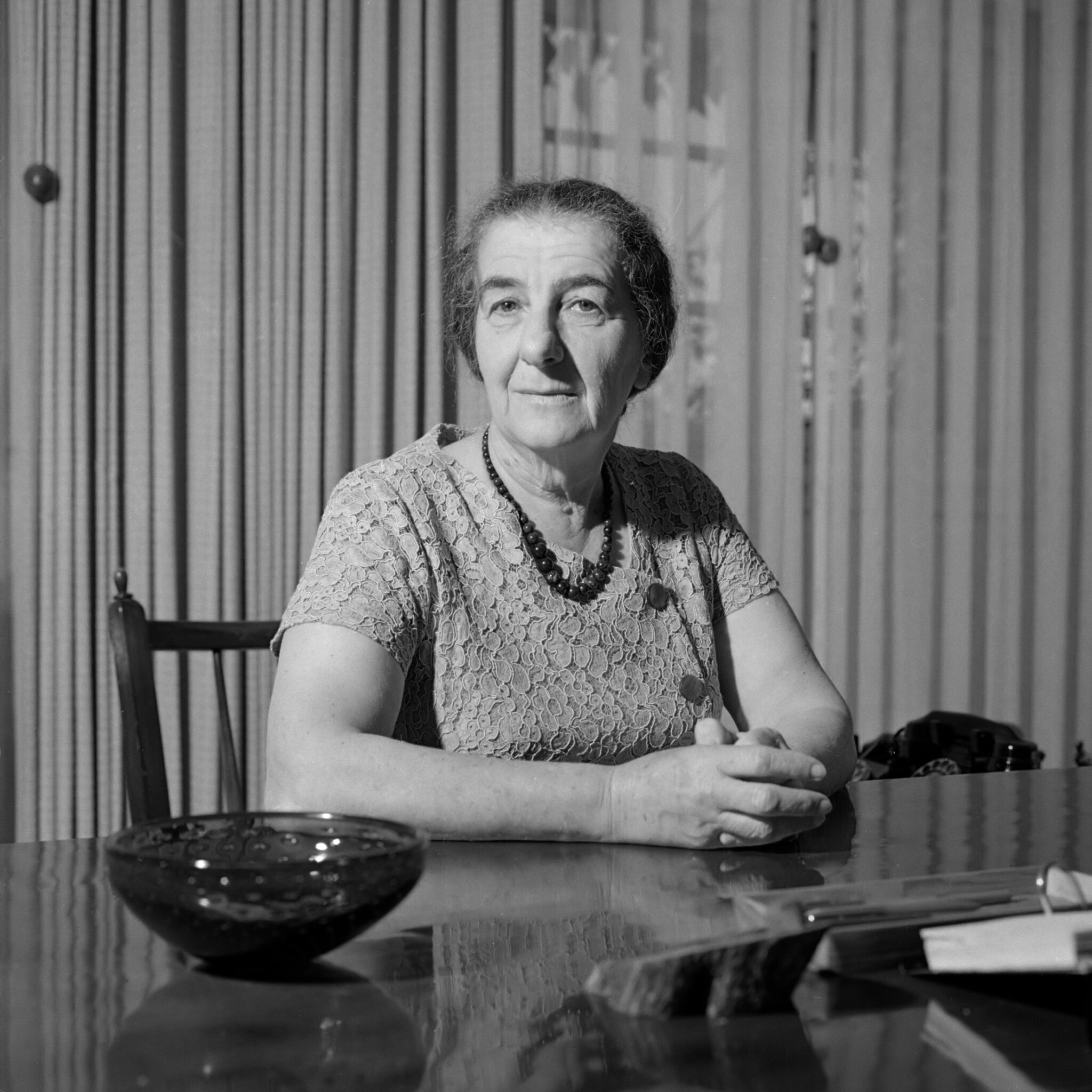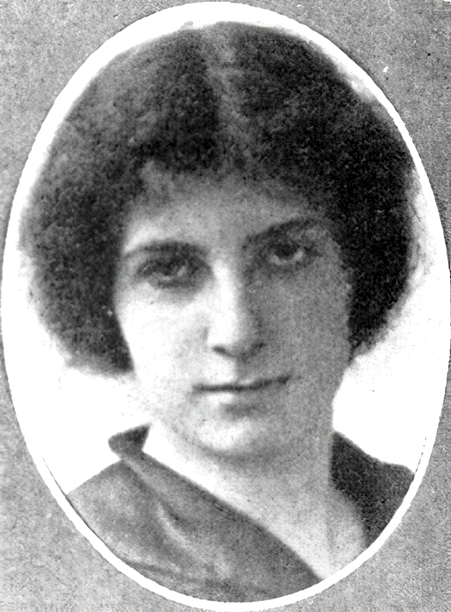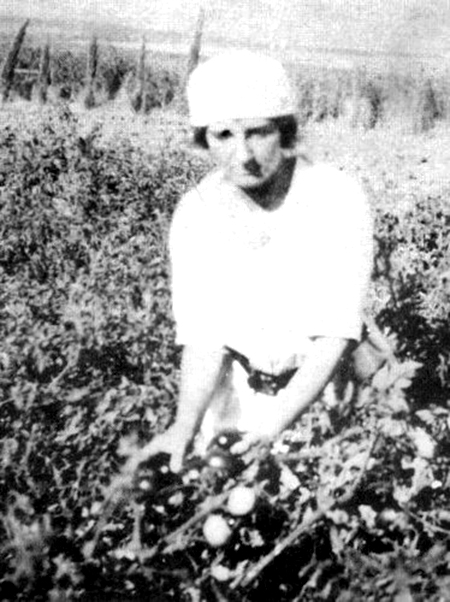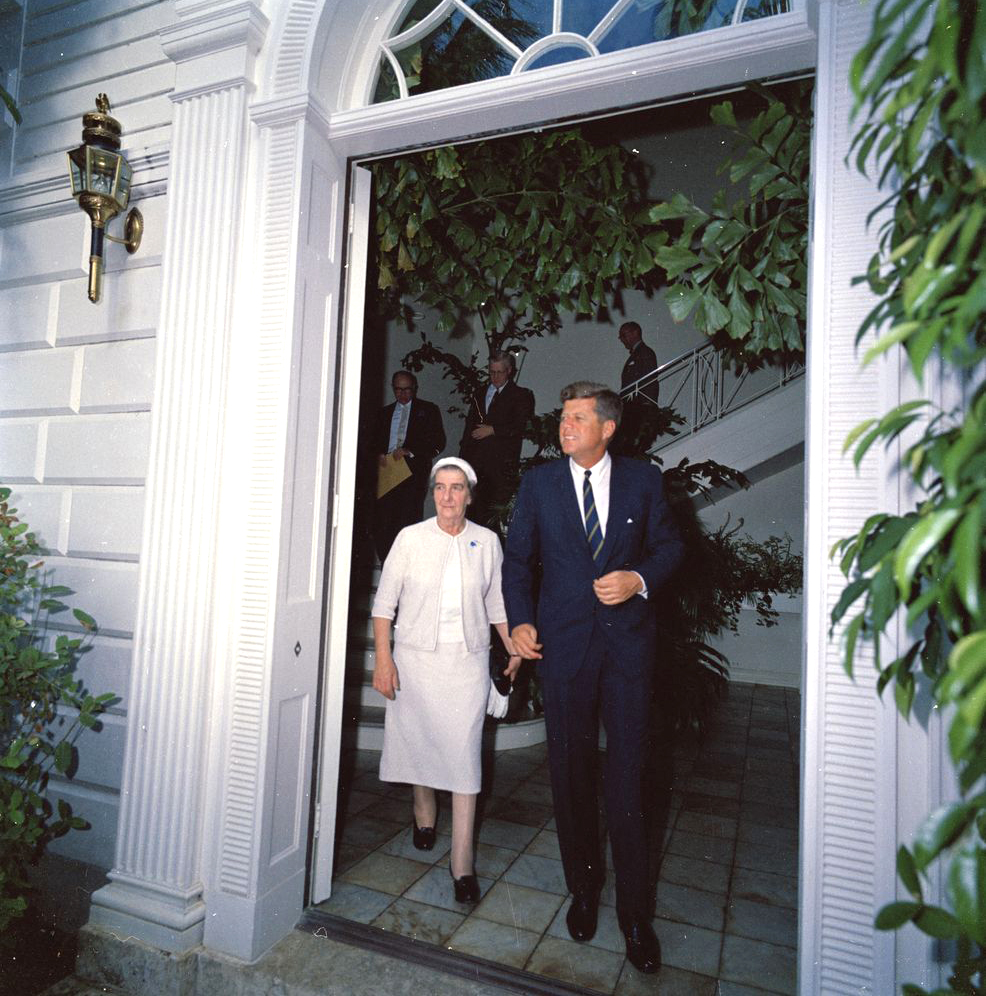The life of Golda Meir: From childhood in Kyiv to leadership in Israel

The Encounters program on Hromadske Radio has invited Olena Kolb, a representative of Kesher Project Ukraine, to talk about Golda Meir, an outstanding Kyiv-born Israeli politician and stateswoman, on the occasion of her birthday anniversary [Ed. — Meir was born on 3 May 1898 in Kyiv and died on 8 December 1978 in Jerusalem].
Yelyzaveta Tsarehradska: Let us begin with some basic definition of what kind of figure Golda Meir was.
Olena Kolb: She was primarily a politician, a unique woman who shaped 20th-century politics in the Middle East and worldwide.
Golda Meir became a self-sacrificing person, laying herself at the altar of Zionism. She was a very controversial and extraordinary person and a great symbol of the entire Jewish people and the Israeli state. She can be called the "mother" of the Jewish people.
Golda Meir’s childhood years in Kyiv
Yelyzaveta Tsarehradska: Golda Meir was born in Kyiv but lived here only a short while before her family left for the USA. How can this period be characterized? What kind of experience did she have in early childhood?
Olena Kolb: Her family originally came from Pinsk in Belarus, which was part of the Russian Empire at the time. Her parents moved to Kyiv in search of a better life, and Golda was born here. She had an older sister, Sheyna, and a younger sister, Tzipke, while five other siblings died in childhood.
Fear in memories of the Russian Empire

Olena Kolb: Golda Meir spent her childhood years first in Kyiv and later in Pinsk after her family moved back there. After several years in Pinsk, she left for the USA to live with her father. He planned to take his family to some level eventually. Unfortunately, he did not get the job he wanted and hoped for in Kyiv. So, he left for America in search of a happy life. He was among many emigrants — Jews, Poles, Ukrainians, and Russians — who fled from the regime in the Russian Empire.
Golda Meir herself says about this period in her memoirs that she remembered fear. The fear of being different and facing the danger of being killed for that. She didn't really understand how exactly it happened and what a pogrom was, for example. However, she was well aware that her father and their neighbor boarded up the door to their house in Kyiv. The only thing they could use to contain hooligans who were planning to kill them was wooden planks. Golda, a neighbor girl, and her sisters had to sit still and be very quiet to avoid being noticed.
So, those were her formative experiences related to our territories and dominated by fear. In her memoirs, Golda Meir says she often told her children and grandchildren about this period. She would tell them about life in Kyiv, of which she had some memories, and her greatest joy was that it was just a lesson in history for them.
Golda Meir was always very happy that her experience of living in the Russian Empire was only an important part of history and heritage for her children and grandchildren and that they could not identify with it as they were born in another land.
What shaped Golda Meir’s personality
Yelyzaveta Tsarehradska: Let’s discuss the environment and circumstances that shaped Golda. To what extent did traditions and religion influence her? What do we know about it?
Olena Kolb: We know a lot from Golda Meir’s autobiography My Life. This book became a New York Times bestseller and stayed among bestselling titles for years.
A story about grandfather
Olena Kolb: Golda Meir talks a lot about what influenced her. Initially, she thought her grandfather on her father's side, Mabovitch, whom she never met, had no impact on her life. A very stubborn man, he was “drafted into the Russian army at the age of 13," according to her memoirs. The Russian army had a quota for Jewish conscripts, and they usually drafted Jewish boys at the age of 13, when they came of age according to Jewish law. The imperial authorities usually took them away even before their coming of age in order to assimilate them, make them convert to Christianity, and turn them into regular citizens of the Russian Empire. Conscripted into the army for 25 years, they were essentially separated from their families.
Golda’s grandfather was also conscripted at this age and spent 13 years in the army. He came from a very pious family and mentioned eating nothing but bread and vegetables during his service. That is, he did not eat forbidden meat. It was not necessarily pork. Even a cow that was not slaughtered according to Jewish law was considered trefa in the Jewish tradition, and its meat was not to be consumed.
They constantly tried to humiliate him in the army. He was insulted, always oppressed, and spent long hours kneeling on the stone floor. Nevertheless, he remained faithful to Jewish tradition and religion.
Thirteen years later, he returned home filled with worries that he might have unknowingly broken some points of the Jewish law, and so he kept atoning for his possible sins. He always slept on a bare bench and lived very modestly. Golda Meir later wrote that these stories — and hence, her grandfather himself — made a strong impression on her.
Golda's rebellious sister Sheyna
Olena Kolb: Talking about the Meir family, or rather the Mabovitch family, all of Golda’s blood relatives were, as a matter of fact, stubborn. Meir described her father as an extremely stubborn person, and her sister Sheyna was constantly in discussion with her parents over her views. She belonged to the Poalei Zion organization, and her primary opponents at that time were the young people from the Bund organization. Golda herself grew up surrounded by conversations about these disputes between the Bundists and Poalei Zion members. She would sit on the stove high up near the ceiling and listen to what the young people were discussing. And she was very, very much influenced by her sister.
The conflict between Golda’s sister and her father intensified when they emigrated to the USA. The reason was that when a mother and three daughters joined their husband/father in the USA, he wanted to turn them into Americans right away. Literally, on the first day.
He wanted to change their clothes so that they would forget everything except Yiddish, because this was the language they continued to speak at home. Otherwise, they had to become Americans. Meanwhile, Sheyna wanted to remain an Eastern European Jewish girl, refusing to become American. This deeply worried her father and led to conflicts. It caused Sheyna to move out of her parents' home. After rejecting many attractive marriage proposals, she married a guy from Pinsk whom she dated earlier and who came to the USA multiple times. And all of this happened before Golda's eyes.
American and Jewish education
Olena Kolb: The father believed that Golda and her younger sister Tzipke had to receive both American and Jewish education. So, they attended an American school and studied in Talmud Torah, a Jewish school. They also learned to read in Hebrew, as this was the language of instruction in Talmud Torah. It was ancient Hebrew, the language of sacred texts, that they had to learn, rather than spoken Hebrew, which was just beginning to revive at the time.
Golda wrote that this did not have much influence on her. However, I think Hebrew texts did have an impact. No matter how they were perceived or interpreted, I believe Golda was under their influence. This includes sacred texts from the Torah and Talmud. Then, there was the language environment. Golda did not remember how she learned English, but as a public school student, she had to be able to speak the language, as the reasoning goes in her memoirs. English easily entered her life and was a language of communication at school, while only Yiddish was spoken at home.
The decision not to live in the USA
Yelyzaveta Tsarehradska: Can we pinpoint the moment when Golda arrived at a clear decision that she did not want to live in the USA and began working in this direction?
Olena Kolb: It happened around the 1920s. In 1921, Golda left the country together with Sheyna, her children, and Regina, one of her best friends. How did she come to this decision? This is a common story among the Jews of that period and many others later.
When Jews became fascinated with Zionism and started first considering Zionist ideas and then really living by them, they faced a question: How could they be Zionists and not live directly in the land of Israel? In 1921, it was Mandatory Palestine, but it was the land of Israel nonetheless.
For Golda and her sister, not moving to Israel was out of the question. Even their younger sister Tzipke said she would go as soon as she graduated from university.
Even their parents agreed. They did not initially plan to move to Israel, or to make aliyah, to use the Jewish phrase. Nevertheless, they were OK with Golda’s decision.
Moreover, Golda moved to Israel with her husband, Morris Meyerson. Meyerson was her married name, which she later changed to Meir. She went to Israel inspired by the idea of creating a state. Upon arrival, Golda experienced a great shock because Israel was not what she imagined. However, as I said, they were very stubborn and decided to stay in the land of Israel and rebuild it as a country.
Life in a kibbutz

Yelyzaveta Tsarehradska: Golda arrived there with her husband and, as I understand, lived in a kibbutz. But they were unable to get into a kibbutz right away, which is also interesting and indicative of their familial stubbornness. How did Golda go from living in a kibbutz, where she worked in the kitchen, to becoming a political figure?
Olena Kolb: This is another fascinating story. In fact, Golda was a public figure back in the USA at the age of 10. While studying at school, she realized that not all the girls there could afford to buy textbooks. So, she and her friend Regina set up the organization "American Society of Young Sisters." It was not registered and operated unofficially, but it held its first meeting, bringing together people from the neighborhood where they lived. Their organization raised money to buy textbooks for children.
When Golda came to Israel, she first lived in Tel Aviv. They ran out of money very quickly there, even though they were considered rich as they had arrived from America. Meanwhile, she and her husband applied to live in a kibbutz. Unfortunately, the kibbutz did not immediately want to accept them for three grave reasons.
First, they were married, and the kibbutz people were actually very worried that they would have children. This would have been a complication as they had to work hard there. The second deterrent was that they were Americans. Americans were considered very soft and not fit for hard physical labor in Israel at that time. The third reason, which they didn't want to tell Golda about but then finally shared with her, was that she got a job as an English teacher, not some hard job, upon arriving in Tel Aviv. That's why everyone in the kibbutz believed she was a soft American who didn't know how to work with her hands and that she would be like that in the kibbutz, avoiding physical labor.
Growth as an activist
Their application was confirmed a few months later, after which they started living in the kibbutz. It was very interesting for Golda. She began developing into a political activist there and even represented her kibbutz at an event organized to discuss kibbutz life in 1922. For example, one of the questions on the agenda was the number of times a mother had to visit her children in kindergarten. In general, the kibbutz was a fascinating formation at the time.
First, the kibbutzniks had everything the same and shared everything. This means that they shared dishes and clothes and ate all together.
All the girls wore the same dresses, and the men wore the same pants. It was all washed together, and later you would simply grab clothes for yourself according to your size, even though a completely different person could have worn them the day before. Children also studied or were in kindergarten all together. The kibbutz even decided how to raise children. There were no individual showers or bathrooms. Everything was shared.
Working in the kitchen
Olena Kolb: Golda went to an event to represent her kibbutz and argued in fierce debates about how to move forward with kibbutz life. She worked in the kitchen, which was usually perceived as a not-very-pleasant place to work in a kibbutz.
Women were usually forced into the kitchen. At the time, women fought hard for their rights to be on an equal footing with men. They insisted they had to, for example, build houses, construct roads, and do the same hard physical work as men. Golda began to change the attitude of women to the fact that they worked in the kitchen. She said: "It's the same kind of hard work. You are doing this not for yourself but for the kibbutz."
Golda Meir's innovations
Olena Kolb: Golda Meir was the first to introduce oatmeal into the kibbutz diet. Initially, it received a hostile reception; people said those were American whims. However, she was successful in spreading this practice to everyone. Oatmeal could easily be served hot, and she believed that hot food had to be consumed, especially during hard work. Then, she instructed residents to skin herring. They ate a lot of herring without skinning it. So, people would wipe their hands on their clothes after meals as no paper was available for that purpose. By skinning the fish, they put an end to that practice.
Golda Meir also changed the way they made cookies for breakfast on Saturdays. They started adding more flour and water to produce enough cookies for Friday night and Saturday morning. She also introduced tablecloths. The kibbutzniks had very limited supplies. So, she laid some sheets on the table, saying there had to be a tablecloth for the festive dinner on Friday because the Sabbath was coming.
Golda Meir worked in the kitchen and on a poultry farm and was proud to do many kinds of work, such as planting trees. She also spent a lot of time in various arguments with kibbutz members about life and the future. She was a futurologist and lived in the future, rather than in the present.
Golda Meir's political effectiveness
Yelyzaveta Tsarehradska: Golda Meir had a lot of practical experience and knew how to set up, run, and change processes. I have heard she was most effective as Labor Minister rather than Prime Minister. What is your view on this?
Olena Kolb: Indeed, even Golda herself said she was probably most effective in the office of Minister of Labor and Social Security, which was a long period from 1949 to 1956. She later held the positions of Minister of Foreign Affairs, Minister of Internal Affairs, and Prime Minister. Golda Meir was the ambassador to the Soviet Union, which was actually also very unpleasant for her due to her memories of fleeing from the Russian Empire. She was concerned she did not know Russian or understand the country. The only thing she remembered was fear, so having to represent the newly created Jewish state was a stressful situation for her.
Golda Meir herself thought she was most successful as Minister of Labor and Social Security. I think she believed for the rest of her life that she could have prevented the Yom Kippur war but failed to do so. She took a grave responsibility for this war.

Role model
Yelyzaveta Tsarehradska: What makes Golda Meir interesting to you? Which of her traits stand out?
Olena Kolb: I think she was a very determined woman.
Golda Meir took it upon herself to create the state of Israel. She was relentless, practiced self-sacrifice, and put social needs above personal ambitions. She saw a very serious meaning in this.
Golda Meir is such an interesting example of a woman who probably regretted not becoming a very good wife and mother to her children. She wrote about it, saying that it could have been much better had she paid more attention to her husband. Nevertheless, she chose this path for herself. That's why, for me, Golda Meir is an example of a person striving toward what she wants to achieve. She clearly defined her goal and went for it.
Yelyzaveta Tsarehradska: Thank you for this conversation and such a wonderful story about Golda Meir. We have by no means covered everything we would like to. We refer those interested in learning more to Golda Meir’s autobiography My Life, published in Ukrainian translation.
Olena Kolb: There's a great movie about Golda Meir and the Yom Kippur War, which was released just last year. The film shows in interesting detail Meir’s later years, highlighting how strong and, at the same time, lonely she was. Our Kesher Project Ukraine made a series of postcards about outstanding women from Ukraine who are known worldwide. Golda Meir was probably on our first postcard of the series. She deserves to be remembered, and her life deserves to be known.
About Golda Meir
Golda Meir (Hebrew גּוֹלְדָּה מֵאִיר; née Mabovitch) (21 April [3 May] 1898, Kyiv — 8 December 1978, Jerusalem) was an Israeli politician and stateswoman. Considered to be one of the founders of the State of Israel, she served as the fourth Prime Minister of Israel (1969–1974), Minister of the Interior (1970), Minister of Foreign Affairs (1956–1966), and Minister of Labor and Social Security (1949–1956).
Golda Meir was born in a Jewish family in Kyiv, Russian Empire. In 1906, she emigrated with her family to the USA, where she graduated from a public school in Milwaukee and later worked as a teacher. While in Milwaukee, she embraced the Labor Zionist movement. In 1921, Meir and her husband emigrated to Mandatory Palestine, settling in Merhavia. She later represented their kibbutz in the Histadrut. Golda Meir was promoted to the trade union's executive committee in 1934 and held several key roles at the Jewish Agency during and after World War II. She was a signatory of the Israeli Declaration of Independence in 1948, was elected to the Knesset the following year, and served as Minister of Labor and Social Security until 1956 when Prime Minister David Ben-Gurion appointed her Foreign Minister. She retired from the ministry in 1966 due to health issues.
In 1969, Meir assumed the office of Prime Minister following the death of Levi Eshkol. Early in her tenure, she made a number of diplomatic visits to Western leaders to promote her vision of peace in the region. The outbreak of the Yom Kippur War in 1973 caught Israel by surprise and inflicted heavy early losses on the army. The resulting public anger damaged Meir's reputation. Her Alignment coalition failed to obtain a majority in the next parliamentary elections. Meir resigned the following year and was succeeded by Yitzhak Rabin. Meir died in 1978 of lymphoma and was buried on Mount Herzl.
Meir has been recognized as a founder of the state and described as the "Iron Lady" of Israeli politics but was also widely blamed for the country being caught off guard during the 1973 war.
This program is created with the support of Ukrainian Jewish Encounter (UJE), a Canadian charitable non-profit organization.
Originally appeared in Ukrainian (Hromadske Radio podcast) here.
This transcript has been edited for length and clarity.
Translated from the Ukrainian by Vasyl Starko.
NOTE: UJE does not necessarily endorse opinions expressed in articles and other materials published on its website and social media pages. Such materials are posted to promote discussion related to Ukrainian-Jewish interactions and relations. The website and social media pages will be places of information that reflect varied viewpoints.



















